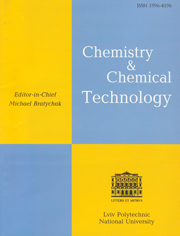Kinetics and Isotherm Studies on Adsorption of Hexavalent Chromium Using Activated Carbon from Water Hyacinth
| Attachment | Size |
|---|---|
| 488.83 KB |
[1] https://eponline.com/articles/2013/05/06/people-affected-by-toxic-waste-...
[2] Kakavandi, B., Kalantary, R. R., Farzadkia, M. et al.: J. Environ. Health Sci., 2014, 12, 115. https://doi.org/10.1186/s40201-014-0115-5
[3] Rai M., Shahi G., Meena V. et al.: Resour. Efficient Technol., 2016, 2, S63. https://doi.org/10.1016/j.reffit.2016.11.011
[4] Alslaibi T., Abustan I., Ahmad M., Foul A.: J. Environ. Chem. Eng., 2013, 1, 589. https://doi.org/10.1016/j.jece.2013.06.028
[5] Langmuir I.: J. Am. Chem. Soc., 1916, 38, 2221. https://doi.org/10.1021/ja02268a002
[6] Freundlich H.: J. Phys. Chem., 1906, 57, 385.
[7] Alslaibi T., Abustan I., Ahmad M., Foul A.: Desalin. Water Treat., 2015, 54, 166. https://doi.org/10.1080/19443994.2013.876672
[8] Lagergren S.: Kungliga Svenska Vetenskapsakademiens Handlingar, 1898, 24, 1.
[9] Hesas R., Arami-Niya A., Daud W., Sahu J.: BioResources, 2013, 8, 2950. https://doi.org/10.15376/biores.8.2.2950-2966
[10] Ţucureanu V., Matei A., Avram A.: Crit. Rev. Anal. Chem., 2016, 46, 502, https://doi.org/10.1080/10408347.2016.1157013
[11] Lafi R., Montasser I., Hafiane A.: Adsorpt. Sci. Technol.: 2018, 37, 160. https://doi.org/10.1177/0263617418819227
[12] Silverstein R., Webster F., Kiemle D. et al.: Spectrometric Identification of Organic Compounds. 8 edn. Wiley 2014.
[13] Anisuzzaman S., Joseph C., Daud W. et al.: Int. J. Ind. Chem., 2015, 6, 9. https://doi.org/10.1007/s40090-014-0027-3
[14] Magoling B., Macalalad A.: BioResources, 2017, 12, 3001. https://doi.org/10.15376/biores.12.2.3001-3016
[15] Yang J., Yu M., Chen W.: J. Ind. Eng. Chem., 2015, 21, 414. https://doi.org/10.1016/j.jiec.2014.02.054
[16] Wanees S., Ahmed A., Adam M., Mohamed M.: Asian J. Chem., 2013, 25, 8245. https://doi.org/10.14233/ajchem.2013.13559
[17] Bhanvase B., Ugwekar R. (Eds.): Process Modeling, Simulation, and Environmental Applications in Chemical Engineering, Apple Academic Press, New York 2016. https://doi.org/10.1201/9781315366449
[18] Cruz G., Pirilä M., Huuhtanen M. et al.: J. Civil. Environ. Eng., 2012, 2, 109. https://doi.org/10.4172/2165-784X.1000109
[19] Dubinin M.: Carbon, 1985, 23, 373. https://doi.org/10.1016/0008-6223(85)90029-6
[20] National Research Council. Drinking Water and Health, vol. 2. The National Academies Press, Washington 1983.https://www.ncbi.nlm.nih.gov/books/NBK234593/
[21] Patil S., Natarajan G., Bhole A.: Indian J. Environ. Health, 2006, 48, 203.
[22] Kang Y., Toh S., Monash P. et al.: Asia-Pac. J. Chem. Eng., 2013, 8, 811. https://doi.org/10.1002/apj.1725
[23] Tan G., Xiao D.: J. Hazard. Mater., 2009, 164, 1359. https://doi.org/10.1016/j.jhazmat.2008.09.082
[24] Dula T., Siraj K., Kitte S.: Int. Scholarly Res. Notice., 2014, 2014. https://doi.org/10.1155/2014/438245
[25] Ho Y., Mckay G.: Process Biochem., 1999, 34, 451. https://doi.org/10.1016/S0032-9592(98)00112-5










